A Traceable Low-Frequency Attenuation Standard from 1 kHz to 10 MHz for Next-Generation Wireless and EMC Calibration
Abstract
1. Introduction
2. Measurement System
2.1. Primary Standard
2.1.1. Measurement Principle in Subrange 1 (1 kHz, 9 kHz, 10 kHz)
2.1.2. Measurement Principle in Subrange 2 (100 kHz–10 MHz)
2.2. Transfer Standard
3. Measurement Experiment and Uncertainty Evaluation
3.1. Primary Standard Evaluation
- (1)
- IVD Reference Standard
- (2)
- System Resolution and Noise
- (3)
- Drift
- (4)
- Nonlinearity
- (5)
- Gauge Block Attenuator (GBA)
- (6)
- Mismatch
3.2. Transfer Standard Evaluation
3.3. System Validation
4. Conclusions
Funding
Data Availability Statement
Acknowledgments
Conflicts of Interest
Abbreviations
| CH | Chanel |
| Coax SW | Co-axial Switch |
| Cplr | Coupler |
| DUT | Device Under Test |
| EMC | Electromagnetic Compatibility |
| GBA | Gauge Block Attenuator |
| GUM | Guide to the Expression of Uncertainty in Measurement |
| Iso Circ | Isolation Circuit |
| IVD | Inductive Voltage Divider |
| LIA | Lock-in Amplifier |
| LNA | Low Noise Amplifier |
| Loc Scr | Local Source |
| LPF | Low Pass Filter |
| Lvl Adj | Level Adjuster |
| Mix | Mixer |
| MW | Microwave |
| NMI | National Metrology Institute |
| NMIJ | National Metrology Institute of Japan |
| Pos | Position |
| PS | Phase Shifter |
| REF | Reference |
| RF | Radio Frequency |
| SDOM | Standard Deviation of the Mean |
| Sig Scr | Signal Source |
References
- Beatty, R.W. Microwave Attenuation Measurements and Standards; National Bureau of Standards: Boulder, CO, USA, 1967. [Google Scholar]
- Warner, F.L. Microwave Attenuation Measurement; Peter Peregrinus: London, UK, 1977. [Google Scholar]
- Coster, A. Attenuation Measurement. In Book Microwave Measurements, 3rd ed.; Collier, R., Skinner, D., Eds.; The Institute of Engineering and Technology: London, UK, 2007; pp. 91–120. [Google Scholar]
- Collin, R.E. Foundations for Microwave Engineering, 2nd ed.; Wiley-IEEE Press: Hoboken, NJ, USA, 2001. [Google Scholar]
- Pozar, D.M. Microwave Engineering, 4th ed.; Wiley: Hoboken, NJ, USA, 2011. [Google Scholar]
- Matthaei, G.L.; Young, L.; Jones, E.M.T. Microwave Filters, Impedance-Matching Networks, and Coupling Structures; Artech House: Norwood, MA, USA, 1980. [Google Scholar]
- Gupta, K.C.; Garg, R.; Bahl, I.; Bhartia, P. Microstrip Lines and Slotlines; Artech House: Norwood, MA, USA, 1996. [Google Scholar]
- Tse, D.; Viswanath, P. Fundamentals of Wireless Communication; Cambridge Univ. Press: Cambridge, UK, 2005. [Google Scholar]
- Saunders, S.; Aragón-Zavala, A. Antennas and Propagation for Wireless Communication Systems; Wiley: Hoboken, NJ, USA, 2007. [Google Scholar]
- IEEE Std 1309-2013; IEEE Standard for Calibration of Electromagnetic Field Sensors and Probes (Excluding Antennas) from 9 kHz to 40 GHz: New York, NY, USA, 2013.
- Ott, H.W. Electromagnetic Compatibility Engineering, 2nd ed.; Wiley: Hoboken, NJ, USA, 2009. [Google Scholar]
- Clark, R.F. Superheterodyne measurement of microwave attenuation at a 10 kHz intermediate frequency. IEEE Trans. Instrum. Meas. 1969, 18, 225–231. [Google Scholar] [CrossRef]
- Solmo, P.I. A voltage doubling circuit for absolute calibration of 30-MHz attenuation measurement systems. IEEE Trans. Instrum. Meas. 1978, 27, 76–78. [Google Scholar] [CrossRef]
- Kawakami, T. 30-MHz attenuation standard using binary phase modulation method. IEEE Trans. Instrum. Meas. 1989, 38, 448–450. [Google Scholar] [CrossRef]
- Kawakami, T. RF attenuation measurement system with 1-kHz voltage ratio standard. IEEE Trans. Instrum. Meas. 1993, 42, 1014–1019.a. [Google Scholar] [CrossRef]
- Russell, D.H. The waveguide below-cutoff attenuation standard. IEEE Trans. Instrum. Meas. 1997, 45, 2408–2413. [Google Scholar]
- Lee, J.G.; Kim, J.H.; Park, J.I.; Kang, U.T. Uncertainty evaluation of a broadband attenuation standard. IEEE Trans. Instrum. Meas. 2005, 54, 705–708. [Google Scholar] [CrossRef]
- Gao, Q.L.; Liang, W.; Huang, H.; Chen, H. Design of attenuation calibrator. In Proceedings of the 2006 Conference on Precision Electromagnetic Measurements Digest, Torino, Italy, 9–14 July 2006. [Google Scholar]
- Widarta, A.; Iida, H.; Kawakami, T. Attenuation-Measurement System in the Frequency Range of 18–40 GHz. IEEE Trans. Instrum. Meas. 2007, 56, 641–645. [Google Scholar] [CrossRef]
- Wu, T.Y.; Chua, S.W. Broadband microwave attenuation measurement standard in the frequency range from 10 MHz to 26 5 GHz. In Proceedings of the IEEE Instrumentation and Measurement Technology Conference, Singapore, 5–7 May 2009. [Google Scholar]
- Iida, H.; Widarta, A.; Kawakami, T.; Komiyama, K. Attenuation Standard in the Frequency Range of 50–75 GHz. IEEE Trans. Instrum. Meas. 2010, 59, 2921–2929. [Google Scholar] [CrossRef]
- Wu, T.Y. Accurate measurement of millimeter-wave attenuation from 75 GHz to 110 GHz using a dual-channel heterodyne receiver. Measurement 2012, 45, 1105–1110. [Google Scholar] [CrossRef]
- Gao, Q.L.; Li, Y.; Liang, W.; Huang, H. A novel hybrid-channel attenuation measurement system at 50–110 GHz. IEEE Trans. Instrum. Meas. 2016, 65, 1865–1873. [Google Scholar] [CrossRef]
- CISPR 16-2-1:2014; Specification for Radio Disturbance and Immunity Measuring Apparatus and Methods—Part 2-1: Methods of Measurement of Disturbances and Immunity—Conducted Disturbance Measurements. International Electrotechnical Commission: Geneva, Switzerland, 2014.
- ANSI C63.5-2017; American National Standard for Electromagnetic Compatibility—Radiated Emission Measurements in Electromagnetic Interference (EMI) Control—Calibration and Qualification of Antennas (9 kHz to 40 GHz). American National Standards Institute/Institute of Electrical and Electronics Engineers: Washington, DC, USA, 2017. Available online: https://ebooks.mpdl.mpg.de/ebooks/Record/EB001577861 (accessed on 22 September 2025).
- Kilby, G.K.; Smith, T.A.J.; Warner, F.L. The accurate measurement of high attenuation at radio frequencies. IEEE Trans. Instrum. Meas. 1995, 44, 308–311. [Google Scholar] [CrossRef]
- Lee, J.L.; Kang, T.W.; Hong, Y.P.; Kwon, J.Y. Attenuation measurement using the IF substitution method in the frequency range of 9 kHz to 10 MHz. J. Electromagn. Eng. Sci. 2024, 4, 370–376. [Google Scholar] [CrossRef]
- International Bureau of Weights and Measures. Key and Supplementary Comparisons. 2025. Available online: https://www.bipm.org/kcdb/ (accessed on 29 July 2025).
- Widarta, A. Primary standard of attenuation in the frequency range of 1 kHz to 10 MHz. In Proceedings of the 2020 Conference on Precision Electromagnetic Measurements (CPEM), Denver, CO, USA, 24–26 Aug. 2020. [Google Scholar]
- Widarta, A. Double step technique for accurate microwave high attenuation measurements. IEICE Trans. Electron. 2024, 107, 349–354. [Google Scholar] [CrossRef]
- Widarta, A. Simple and accurate radio frequency attenuation measurements using general-purpose receiver. In Proceedings of the ICEE 2008, O-063, Okinawa, Japan, 6–10 July 2008. [Google Scholar]
- ISO. Guide to the Expression of Uncertainty in Measurement, 1st ed.; International Organization for Standardization (ISO): Geneva, Switzerland, 1993. [Google Scholar]
- ISO/IEC 17025:2017(E); General Requirements for the Competence of Testing and Calibration Laboratories, 3rd ed. International Organization for Standardization (ISO): Geneva, Switzerland, 2017.
- Harris, I.A.; Warner, F.L. Re-examination of mismatch uncertainty when measuring microwave power and attenuation. Proc. Inst. Electr. Eng. 1981, 128, 35–41. [Google Scholar] [CrossRef]
- Keysight Technologies. Vector Network Analyzer Uncertainty Calculator. Available online: https://www.keysight.com/us/en/lib/software-detail/computer-software/downloadable-vector-network-analyzer-uncertainty-calculator-1000000418epsgsud.html (accessed on 22 September 2025).
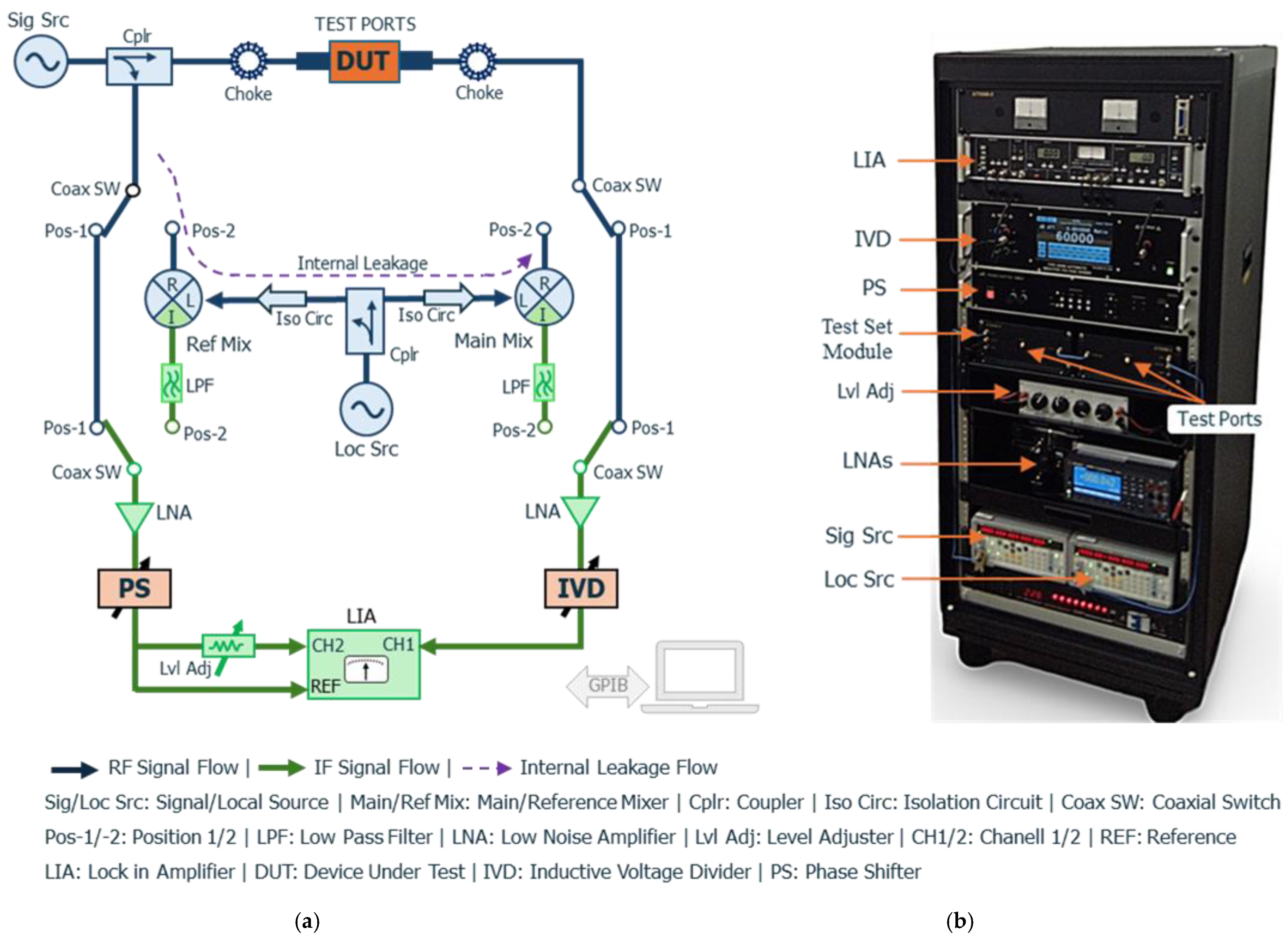

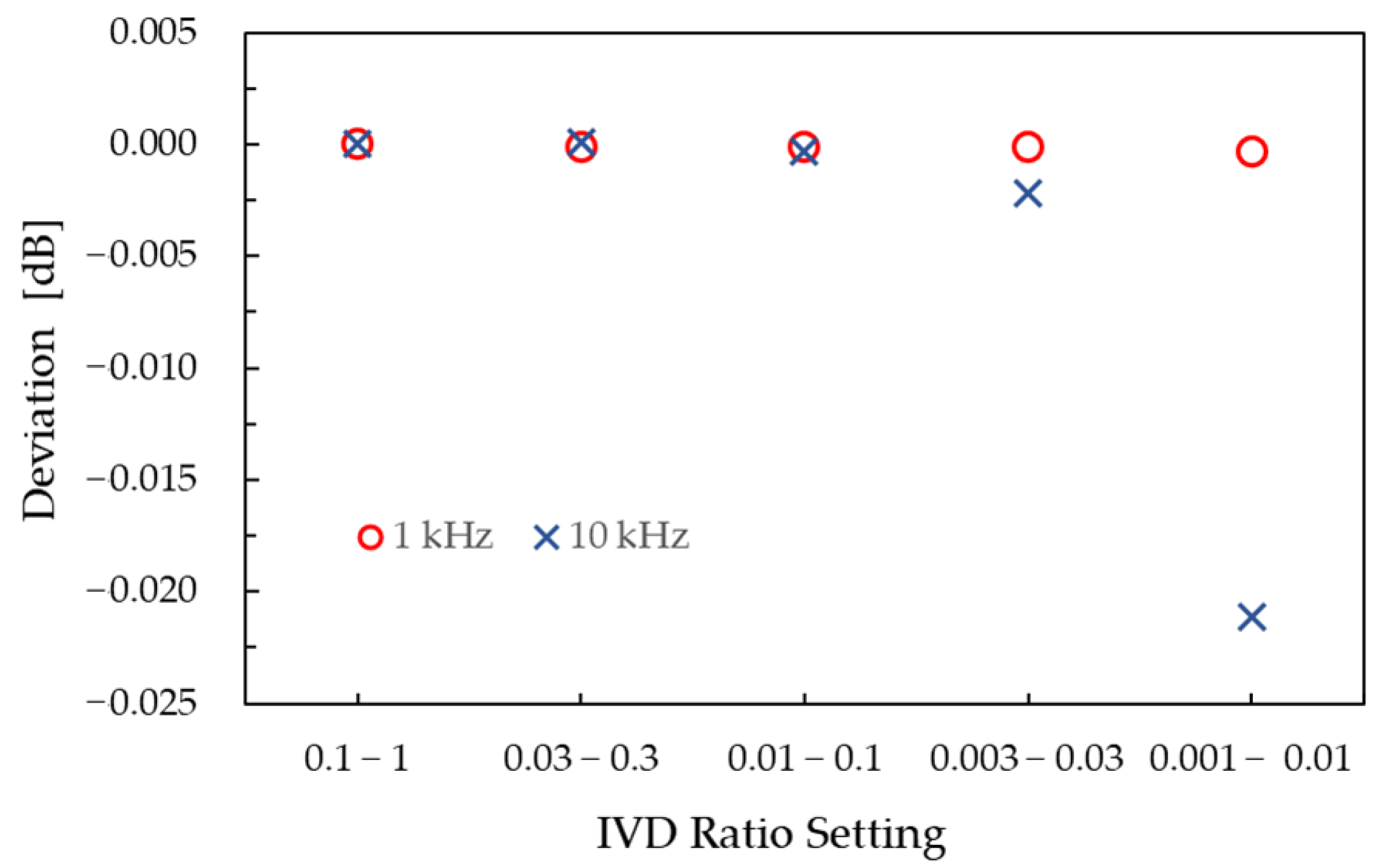
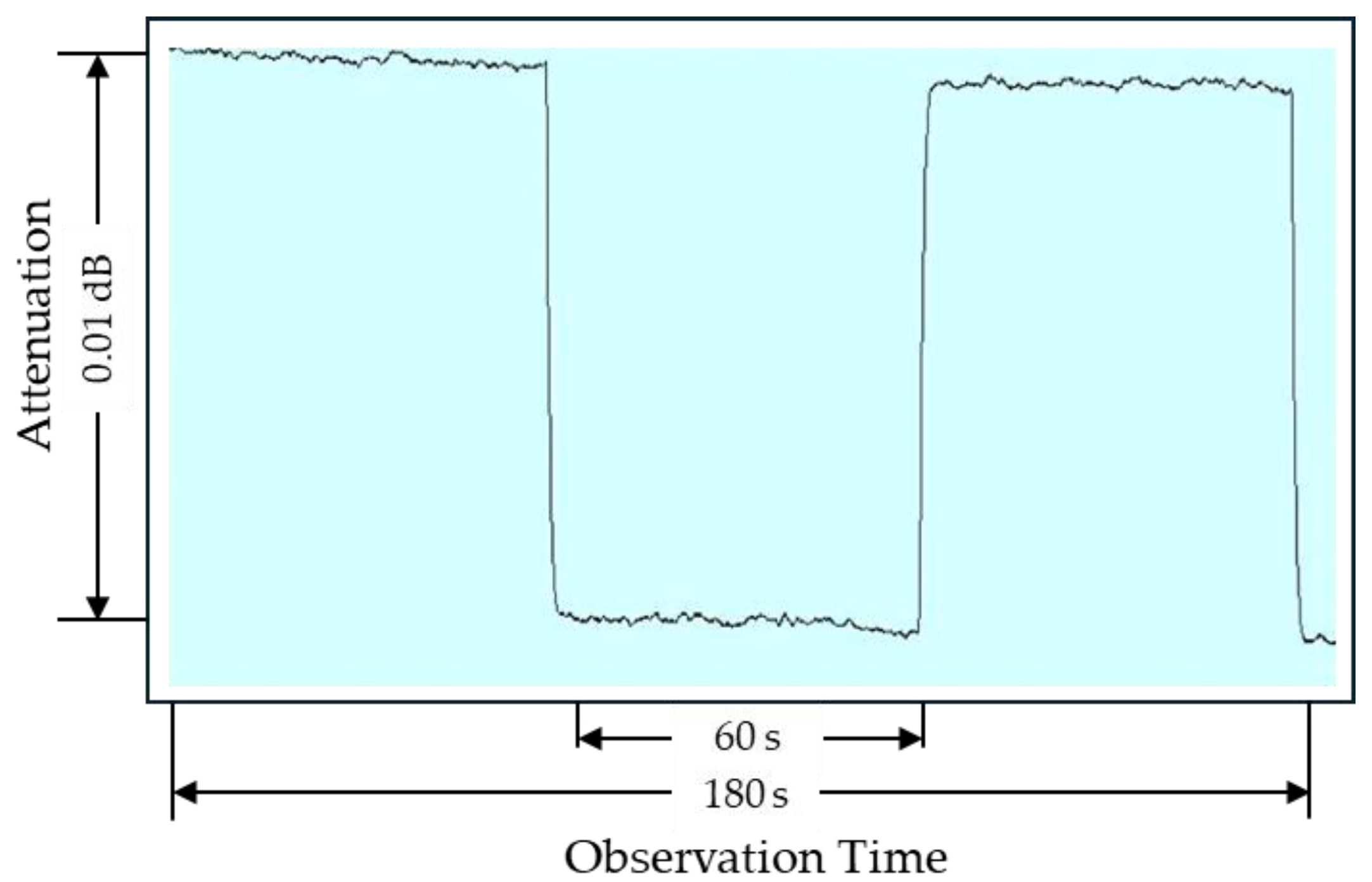

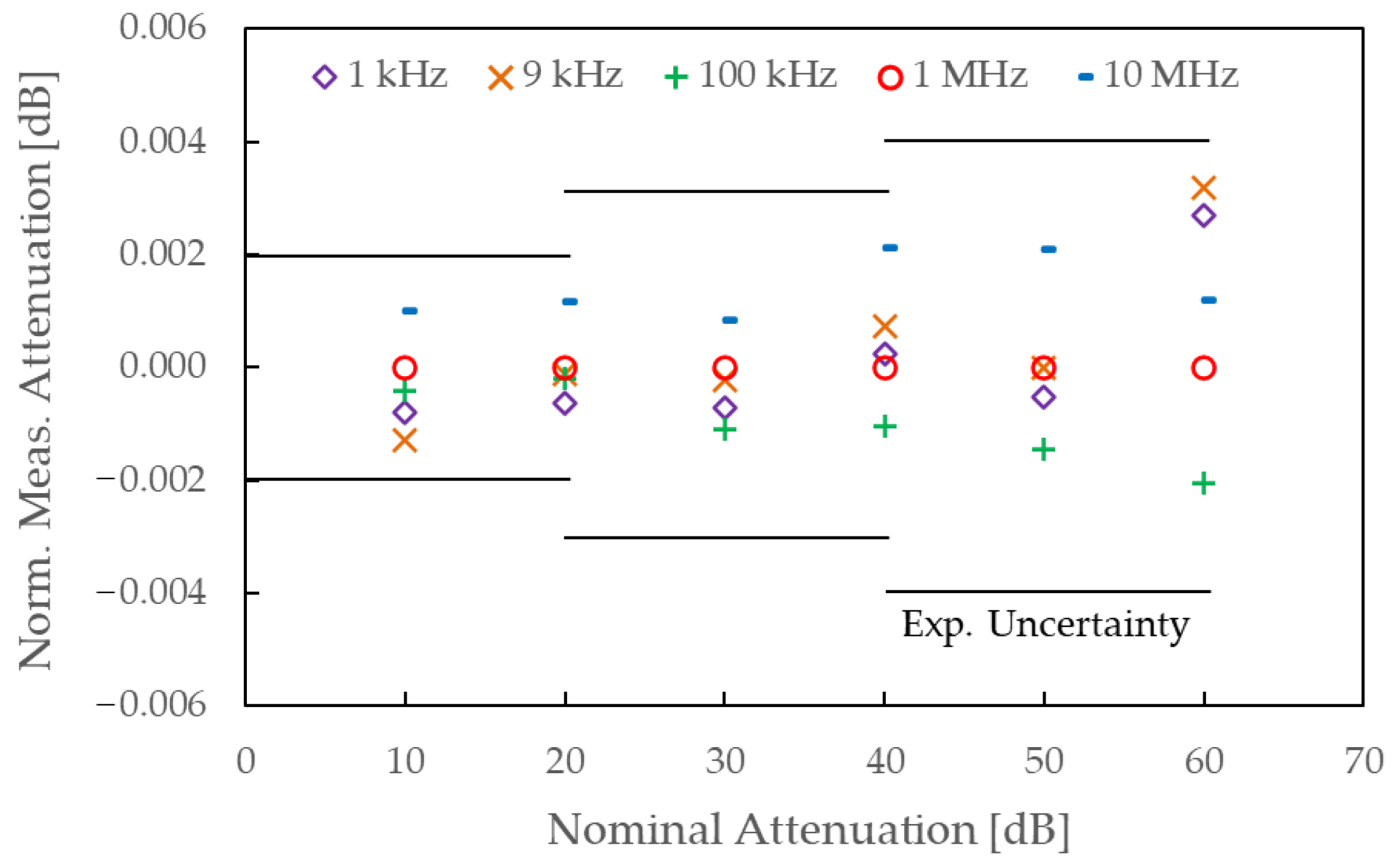
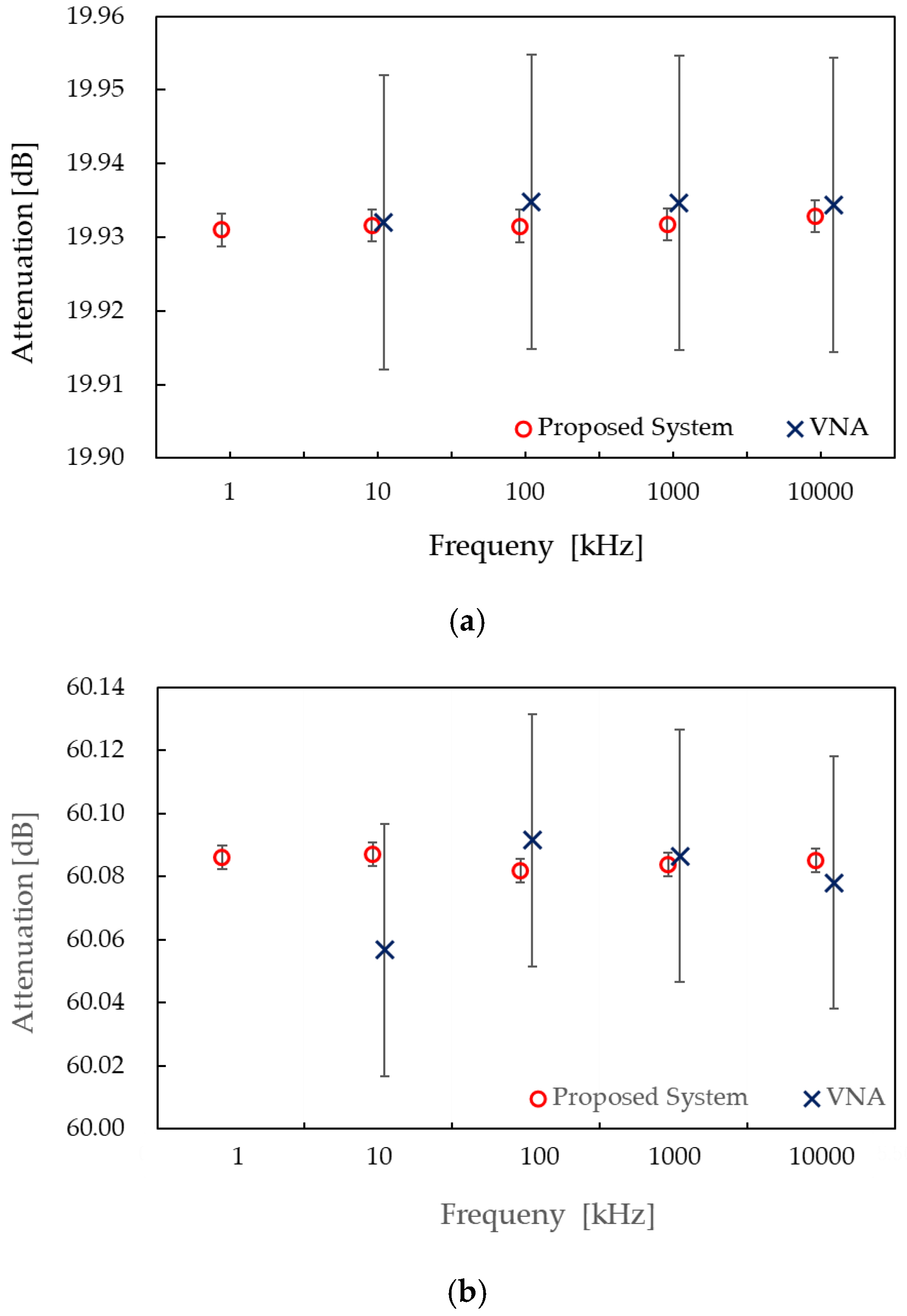
| Nominal Attenuation [dB] | IVD Setting | Frequency [kHz] | ||
|---|---|---|---|---|
| 1 | 10 | |||
| Maximum Calibration Uncertainty of IVD σ | ||||
| 1.0 × 10−7 | 3.0 × 10−6 | |||
| Si | Sf | Limit of Atten. Meas. Uncertainty ΔA [dB] | ||
| 20 | 0.1 | 1 | 8.7 × 10−6 | 2.6 × 10−4 |
| 40 | 0.01 | 1 | 8.7 × 10−5 | 2.6 × 10−3 |
| 60 | 0.001 | 1 | 8.7 × 10−4 | 2.6 × 10−2 |
| Nominal Attenuation [dB] | IVD Setting | Frequency [Hz] | ||
|---|---|---|---|---|
| 1 | 10 | |||
| Si | Sf | Limit of Atten. Meas. Uncertainty ΔA [dB] | ||
| 20 | 0.1 | 1 | 2.5 × 10−6 | 7.5 × 10−5 |
| 40 | 0.01 | 1 | 2.5 × 10−5 | 7.5 × 10−4 |
| 60 | 0.001 | 1 | 2.5 × 10−4 | 7.5 × 10−4 |
| Uncertainty Source | Cat. | Prob. Dis. | Frequency [Hz] | ||||||
|---|---|---|---|---|---|---|---|---|---|
| 1 k, 100 k to 10 M | 9 k, 10 k | ||||||||
| Nominal Attenuation [dB] | |||||||||
| 20 | 40 | 60 | 20 | 40 | 60 | ||||
| u(Xi) [dB] | u(Xi) [dB] | u(Xi) [dB] | u(Xi) [dB] | u(Xi) [dB] | u(Xi) [dB] | ||||
| 1 | IVD Ref. Std. | B | Unif. | 2.5 × 10−6 | 2.5 × 10−5 | 6.7 × 10−4 | 7.5 × 10−5 | 7.5 × 10−4 | 7.5 × 10−4 |
| 2 | Sys. Res./Noise | B | Unif. | 1.4 × 10−4 | 2.9 × 10−4 | 8.7 × 10−4 | 1.4 × 10−4 | 2.9 × 10−4 | 8.7 × 10−4 |
| 3 | Drift | B | Unif. | 2.9 × 10−4 | 2.9 × 10−4 | 2.9 × 10−4 | 2.9 × 10−4 | 2.9 × 10−4 | 2.9 × 10−4 |
| 4 | Nonlinearity | B | Unif | 1.7 × 10−4 | 2.9 × 10−4 | 8.4 × 10−4 | 1.7 × 10−4 | 2.9 × 10−4 | 8.4 × 10−4 |
| 5 | Gauge Block | B | Unif. | 3.7 × 10−4 | |||||
| 6 | Mismatch | B | U | 1.0 × 10−3 | 1.0 × 10−3 | 1.0 × 10−3 | 1.0 × 10−3 | 1.0 × 10−3 | 1.0 × 10−3 |
| 7 | SDOM | A | Norm. | 1.0 × 10−4 | 6.0 × 10−4 | 8.0 × 10−4 | 1.0 × 10−4 | 6.0 × 10−4 | 8.0 × 10−4 |
| uc | Combine Standard Unc. | 1.1 × 10−3 | 1.3 × 10−3 | 1.9 × 10−3 | 1.1 × 10−3 | 1.5 × 10−3 | 2.0 × 10−3 | ||
| U | Expanded Uncertainty | 2.2 × 10−3 | 2.6 × 10−3 | 3.8 × 10−3 | 2.2 × 10−3 | 3.0 × 10−3 | 4.0 × 10−3 | ||
Disclaimer/Publisher’s Note: The statements, opinions and data contained in all publications are solely those of the individual author(s) and contributor(s) and not of MDPI and/or the editor(s). MDPI and/or the editor(s) disclaim responsibility for any injury to people or property resulting from any ideas, methods, instructions or products referred to in the content. |
© 2025 by the author. Licensee MDPI, Basel, Switzerland. This article is an open access article distributed under the terms and conditions of the Creative Commons Attribution (CC BY) license (https://creativecommons.org/licenses/by/4.0/).
Share and Cite
Widarta, A. A Traceable Low-Frequency Attenuation Standard from 1 kHz to 10 MHz for Next-Generation Wireless and EMC Calibration. Sensors 2025, 25, 6227. https://doi.org/10.3390/s25196227
Widarta A. A Traceable Low-Frequency Attenuation Standard from 1 kHz to 10 MHz for Next-Generation Wireless and EMC Calibration. Sensors. 2025; 25(19):6227. https://doi.org/10.3390/s25196227
Chicago/Turabian StyleWidarta, Anton. 2025. "A Traceable Low-Frequency Attenuation Standard from 1 kHz to 10 MHz for Next-Generation Wireless and EMC Calibration" Sensors 25, no. 19: 6227. https://doi.org/10.3390/s25196227
APA StyleWidarta, A. (2025). A Traceable Low-Frequency Attenuation Standard from 1 kHz to 10 MHz for Next-Generation Wireless and EMC Calibration. Sensors, 25(19), 6227. https://doi.org/10.3390/s25196227






